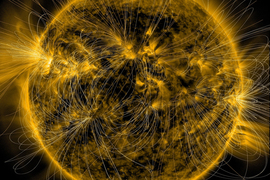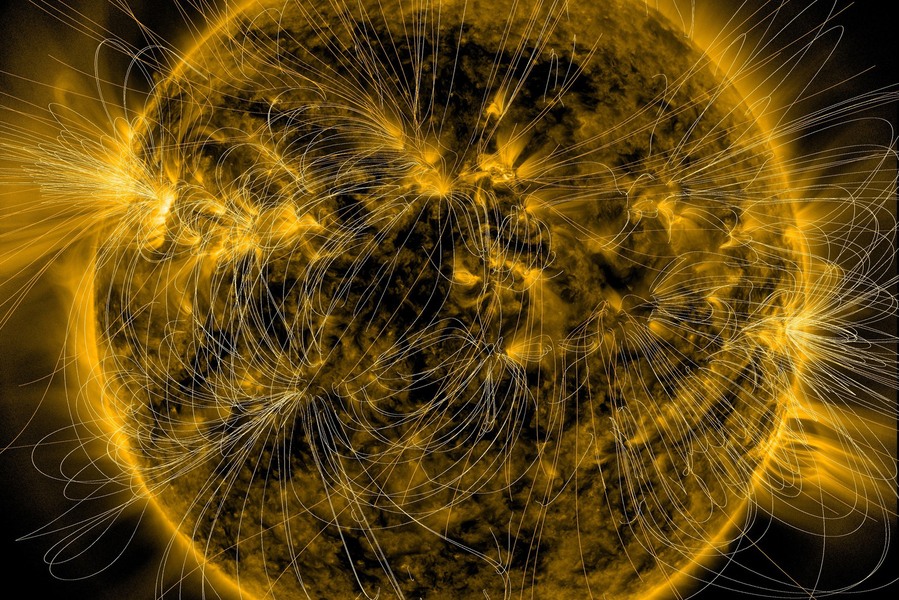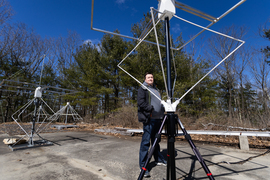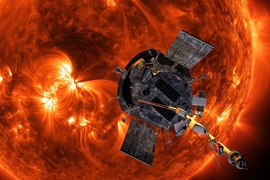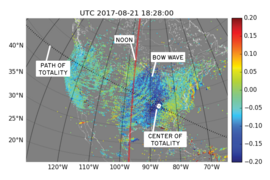The sun’s surface is a brilliant display of sunspots and flares driven by the solar magnetic field, which is internally generated through a process called dynamo action. Astrophysicists have assumed that the sun’s field is generated deep within the star. But an MIT study finds that the sun’s activity may be shaped by a much shallower process.
In a paper appearing today in Nature, researchers at MIT, the University of Edinburgh, and elsewhere find that the sun’s magnetic field could arise from instabilities within the sun’s outermost layers.
The team generated a precise model of the sun’s surface and found that when they simulated certain perturbations, or changes in the flow of plasma (ionized gas) within the top 5 to 10 percent of the sun, these surface changes were enough to generate realistic magnetic field patterns, with similar characteristics to what astronomers have observed on the sun. In contrast, their simulations in deeper layers produced less realistic solar activity.
The findings suggest that sunspots and flares could be a product of a shallow magnetic field, rather than a field that originates deeper in the sun, as scientists had largely assumed.
“The features we see when looking at the sun, like the corona that many people saw during the recent solar eclipse, sunspots, and solar flares, are all associated with the sun’s magnetic field,” says study author Keaton Burns, a research scientist in MIT’s Department of Mathematics. “We show that isolated perturbations near the sun’s surface, far from the deeper layers, can grow over time to potentially produce the magnetic structures we see.”
If the sun’s magnetic field does in fact arise from its outermost layers, this might give scientists a better chance at forecasting flares and geomagnetic storms that have the potential to damage satellites and telecommunications systems.
“We know the dynamo acts like a giant clock with many complex interacting parts,” says co-author Geoffrey Vasil, a researcher at the University of Edinburgh. “But we don't know many of the pieces or how they fit together. This new idea of how the solar dynamo starts is essential to understanding and predicting it.”
The study’s co-authors also include Daniel Lecoanet and Kyle Augustson of Northwestern University, Jeffrey Oishi of Bates College, Benjamin Brown and Keith Julien of the University of Colorado at Boulder, and Nicholas Brummell of the University of California at Santa Cruz.
Flow zone
The sun is a white-hot ball of plasma that’s boiling on its surface. This boiling region is called the “convection zone,” where layers and plumes of plasma roil and flow. The convection zone comprises the top one-third of the sun’s radius and stretches about 200,000 kilometers below the surface.
“One of the basic ideas for how to start a dynamo is that you need a region where there’s a lot of plasma moving past other plasma, and that shearing motion converts kinetic energy into magnetic energy,” Burns explains. “People had thought that the sun’s magnetic field is created by the motions at the very bottom of the convection zone.”
To pin down exactly where the sun’s magnetic field originates, other scientists have used large three-dimensional simulations to try to solve for the flow of plasma throughout the many layers of the sun’s interior. “Those simulations require millions of hours on national supercomputing facilities, but what they produce is still nowhere near as turbulent as the actual sun,” Burns says.
Rather than simulating the complex flow of plasma throughout the entire body of the sun, Burns and his colleagues wondered whether studying the stability of plasma flow near the surface might be enough to explain the origins of the dynamo process.
To explore this idea, the team first used data from the field of “helioseismology,” where scientists use observed vibrations on the sun’s surface to determine the average structure and flow of plasma beneath the surface.
“If you take a video of a drum and watch how it vibrates in slow motion, you can work out the drumhead’s shape and stiffness from the vibrational modes,” Burns says. “Similarly, we can use vibrations that we see on the solar surface to infer the average structure on the inside.”
Solar onion
For their new study, the researchers collected models of the sun’s structure from helioseismic observations. “These average flows look sort like an onion, with different layers of plasma rotating past each other,” Burns explains. “Then we ask: Are there perturbations, or tiny changes in the flow of plasma, that we could superimpose on top of this average structure, that might grow to cause the sun’s magnetic field?”
To look for such patterns, the team utilized the Dedalus Project — a numerical framework that Burns developed that can simulate many types of fluid flows with high precision. The code has been applied to a wide range of problems, from modeling the dynamics inside individual cells, to ocean and atmospheric circulations.
“My collaborators have been thinking about the solar magnetism problem for years, and the capabilities of Dedalus have now reached the point where we could address it,” Burns says.
The team developed algorithms that they incorporated into Dedalus to find self-reinforcing changes in the sun’s average surface flows. The algorithm discovered new patterns that could grow and result in realistic solar activity. In particular, the team found patterns that match the locations and timescales of sunspots that have been have observed by astronomers since Galileo in 1612.
Sunspots are transient features on the surface of the sun that are thought to be shaped by the sun’s magnetic field. These relatively cooler regions appear as dark spots in relation to the rest of the sun’s white-hot surface. Astronomers have long observed that sunspots occur in a cyclical pattern, growing and receding every 11 years, and generally gravitating around the equator, rather than near the poles.
In the team’s simulations, they found that certain changes in the flow of plasma, within just the top 5 to 10 percent of the sun’s surface layers, were enough to generate magnetic structures in the same regions. In contrast, changes in deeper layers produce less realistic solar fields that are concentrated near the poles, rather than near the equator.
The team was motivated to take a closer look at flow patterns near the surface as conditions there resembled the unstable plasma flows in entirely different systems: the accretion disks around black holes. Accretion disks are massive disks of gas and stellar dust that rotate in towards a black hole, driven by the “magnetorotational instability,” which generates turbulence in the flow and causes it to fall inward.
Burns and his colleagues suspected that a similar phenomena is at play in the sun, and that the magnetorotational instability in the sun’s outermost layers could be the first step in generating the sun’s magnetic field.
“I think this result may be controversial,” he ventures. “Most of the community has been focused on finding dynamo action deep in the sun. Now we’re showing there’s a different mechanism that seems to be a better match to observations.” Burns says that the team is continuing to study if the new surface field patterns can generate individual sunspots and the full 11-year solar cycle.
“This is far from the final word on the problem,” says Steven Balbus, a professor of astronomy at Oxford University, who was not involved with the study. “However, it is a fresh and very promising avenue for further study. The current findings are very suggestive and the approach is innovative, and not in line with the current received wisdom. When the received wisdom has not been very fruitful for an extended period, something more creative is indicated, and that is what this work offers.”
This research was supported, in part, by NASA.
